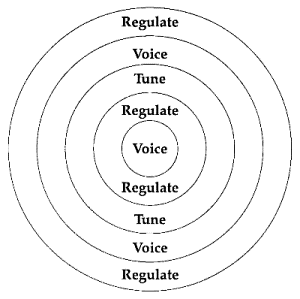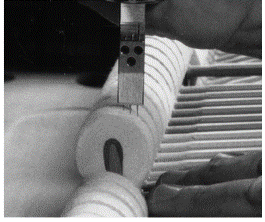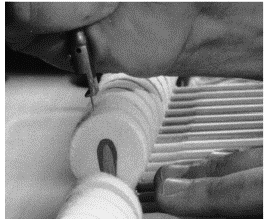BLUEBOOK OF PIANOS
ACTION REGULATION & VOICING
PIANO RATINGS | ARCHIVES | APPRAISALS | PIANO TYPES | BLUEBOOK VALUE | SELL YOUR PIANO
PIANO VOICING
Tuning is the adjustment of the tension of all of your piano's 220 (or more) strings to the correct pitch or frequency. This ensures that notes played in a musical interval (octaves, chords, etc.) will sound in harmony.
Voicing is the adjustment of a piano's tone or quality of sound. Tone can be changed without affecting the pitch. For example, turning the bass or treble knobs on your stereo changes the tone but does not alter the notes the musician recorded. A skilled piano technician can voice a piano to change its tonal personality from mellow to bright or robust to delicate. The degree of change possible depends upon the piano's design and condition. Voicing is done after the piano is tuned, the hammers are softened with a tool that has a series of needles. It refreshes the piano's sound.
VOICING & ACTION REGULATION
A piano cannot be voiced well unless the action is carefully regulated first. The action must be capable of carrying the pianistís nuance through to the hammer, while losing a minimum of energy during powerful passages. Every aspect of the action should be evaluated for proper performance before hammer voicing is begun. If the action is not performing well, the time working with the hammers will be spent attempting to overcome the shortcomings in the action.
Prior to regulation and voicing of the instrument the following areas should be evaluated and problems corrected:
-
 Keyframe (Bedding against the keybed,
keyframe felt condition)
Keyframe (Bedding against the keybed,
keyframe felt condition) -
Key bushings (no excess play or friction)
-
Wippen cushions (wear)
-
Knuckle (Roller) shape and surface
-
Action centers, especially hammer shank centers.
-
These must be free, yet firmly controlled, and even in friction from note to note.
-
The hammer shank centers should measure 2 to 4 grams of friction measured at the screw hole.
Voicing Circle
of refinement
All piano service should progress through ever finer circles of
refinement. At the outermost circles, serious matters must be addressed,
with rough tuning and repairs being made to eliminate the effects of wear
on the action. Then the first regulation should space, travel and align
the parts, and the action should be regulated to specifications. The next
level is tuning and string spacing, then in the next the action spacing
and regulation should be refined, then the first rough voicing can be
done, and so on until the piano has been brought to its potential.
These voicing instructions commence with one of the inner circles of
refinement, after the condition of the action is correct, the regulation
and spacing of the action has been refined, the hammers have been filed to
remove string grooves caused by wear, and the piano is ready for the first
voicing steps.
A. Evaluate the overall tone. Keeping in mind the environment and use for the
instrument, listen to the tone of the piano, playing chords or music at
different volume levels. Listen for harsh or brittle tone, listen for excessive
high harmonics in the bass, listen for dullness and lack of power.
B. Pre-voicing. Hammers are pressed for high compression of the felt. This
compression should remain unchanged under the strike point, where it will give
brightness and power during Forte passages. Some of the tension in the shoulder
areas is released by deep needling the hammers in the factory.
If the high treble is too bright, the same
procedure may be used, but with fewer and shallower penetrations of the
needles, closer to the strike point than in the tenor and bass. If some
part of the scale is too dull, those hammers should be tested for hardness
by needling low down on the shoulders (below 3 0' clock). If the hammers
feel soft and resilient in the low shoulders, needling in this area should
not be necessary. Next, file the hammers on the upper shoulders and at the
strike point to present a harder surface to the strings.
C. Testing / needling again. This process may need to be repeated a few
times until the overall tone of the piano is at the approximate level
desired. Be aware that too much needling will ruin the hammers, especially
if they are needled too close to the strike point. Once the hammers feel
resilient and soft in the shoulders, further needling in that area is not
necessarily going to improve the tone, so moving to a different type of
needling process in a different area should be tried to achieve the
results you are seeking.
D. Shaping. The hammers must now be shaped to remove the excess outer felt which has been loosened by the voicing process. Only the outermost layer of felt should be removed, from the low shoulders all the way up over the strike point. Special attention should be paid to the smoothness of the strike point surface. Using fine sandpaper (400 - 1,000 grit) for the final shaping will allow the surface to be smooth and firm, making the later voicing process simpler. In some cases the use of 1000 grit emery cloth strips to "buff' the surface of the hammers, especially in the treble, will give the best final results and may help brighten the tone somewhat.
 |
 3 - Brightness, Tone Range
3 - Brightness, Tone Range
2 - Fullness, tone bloom 1.- Preparation of the hammers This deep needling is done in two stages in the factory; the first is done mechanically just prior to mounting the hammers on the shanks. |
 |
